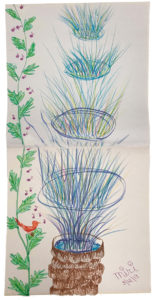Month 11 Moon of Liberation
Dissolve * Release * Liberation
May 2, 2018, Planetary East, Malkut Sepheroth
Wednesday, Yellow Rhythmic Seed, Kin 84, Crown Chakra
Water, and Miriam’s Well is very deep and feminine. I didn’t realize that the Hebrew Books in the Old Testament were accompanied by Midrash, the stories that come down through the ages about certain events in those olden times.
They are rich, and were not written at first like the Native Americans, who had no “Talking Bark.” Also the teachings of the Sophian Gnostic Christianity were originally oral.
I first found a book of these stories at the Washington National Cathedral on July 4th, 1987. My husband had just become a tour guide as his retirement adventure. I was out on the beautiful grounds of the Cathedral. The water features are beautiful, and the gardens each have a different qualities to them. Some were formal, some naturally unstructured, etc. It’s magical to experience such different feelings on the scattered benches.
It seemed natural to find this book of mystical Hebrew Midrash stories at the Cathedral’s bookstore. The cover picture was of Miriam’s Well, but the name of the book did not have Miriam’s Well in the title. Unfortunately, I didn’t bring the book with me, and I have not been able to find the title. If I do, I will post it.
Here is a left handed, 2 part picture I drew in 2013. Interesting that I seemed to have given it a fountain quality of springing forth now. The 5 tiers represent the 5 Sepheroth of the Middle Pillar Of the Kabbalah.
Here are highlighted portions of an article on Miriam’s Well and Midrash posted on the My Jewish Learning web site. To view the entire article click here.
“Careers of public figures take on a life of their own, ebbing and flowing with shifts in public opinion and the latest values. One Jewish figure whose popularity is at an all-time high is the prophet Miriam, the sister of Moses and Aaron.”
“While featured prominently in the Torah, Miriam’s claim to fame always paled in the face of her more visible brothers. After all, Aaron was the first Kohen Gadol (high priest), the link between the Jewish people and their religion, and Moses was the intimate friend of God, transmitting sacred teachings to the people.”
“Compared to those two leaders, Miriam simply faded into the background. True, we celebrate her beautiful song at the shores of the Red Sea, but even that poem is overshadowed by Moses’ far-lengthier song. Today, Miriam’s fame rests less on any specific accomplishment and more on the fact that she was a woman.”
“Three thousand years ago — and in most parts of the world even today — being a woman was itself disqualification from public recognition or accomplishment. With so few female heroes, Miriam stands out precisely because we are now more sensitive to just how difficult it is for a woman to gain public recognition. This Torah portion comments on the death of this prophet, that “Miriam died there and was buried there, and the community was without water.”… Read More At My Jewish Learning.com
The article continues…
“As the Jews wandered through the wilderness, lacking adequate water would have been fatal. However, the power of Miriam’s integrity, piety and caring was such that God provided a moving well of water, one which followed the people throughout their wanderings until the moment of her death. Without Miriam, there was no more water.
… Read More At My Jewish Learning.com
Continued …
“Miriam’s example, paralleled by countless women after her, is one of action — deeds of love and support. Without Miriam’s efforts, no one would have been able to listen to the words of Moses or to study God’s Torah. Acts of caring and love — that is the special gift that women give humanity. Notice, also, that no one comments on her well, on how important and valued her contribution is until after she has died.”
Continued …
“The tragic reality is that for most women, after-the-fact recognition is often the only kind that is given. The women who work in the homes raising children, the women who work in the schools teaching students, the women who work in hospitals tending the sick, these and countless other women perform the difficult, tedious tasks that sustain and make human life possible.”
… Read More At My Jewish Learning.com
Continued …
“Do we sufficiently honor those whose contribution is quiet support of others? Do we still relegate such vital care to one specific group, or have we each undertaken to make ourselves not only disciples of Aaron, not only children of Moses, but also personifications of Miriam — using our hands and hearts, just as she did, to irrigate the lives of our people and of all people?”
… Read More At My Jewish Learning.com
Parts were Reprinted with permission, (to My Jewish Learning), from The American Jewish University.
Deep Gratitude to The American Jewish University for this article.








